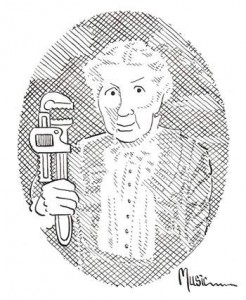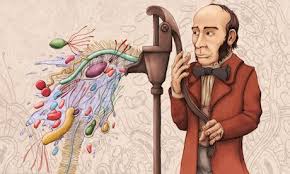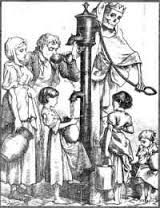A Landmark Event in the Understanding and Control of Waterborne Diseases
by Pure Water Annie
Gazette technical writer Pure Water Annie describes a landmark moment in the history of water’s role in disease.
Waterborne diseases like infectious hepatitis, bacterial dysentery, cholera, and giardiasis were common until fairly recently. Throughout the world, health impacts were staggering. Entire villages in Europe were wiped out by plagues in the 11th and 12th centuries. In 1848 and 1849 in a single cholera epidemic alone, 53,000 people died in London.
Dr. John Snow’s 1854 Pump Study is a landmark in the development of epidemiology (the study of infectious diseases).
The Broad Street Pump Findings
Dr. John Snow, a London obstetrician, became interested in the cause and transmission of cholera after witnessing severe outbreaks of the disease in the 1830s and 1840s. In 1849 he published a pamphlet that suggested that cholera was transmitted by contaminated drinking water. Many theories about the cause of cholera were in circulation at the time, and Dr. Snow’s polluted water theory was not widely accepted. The then-dominant theory was the miasma theory that stated that diseases such as cholera or the Black Death were caused by a noxious form of “bad air.” This was a short time before Pasteur’s “germ theory” became popular.
In 1854 Dr. Snow carefully plotted the locations of the illness and compared his findings to the subscriber lists of two private companies that provided water for London. His research showed that cholera occurred with greater frequency among the customers of one of the companies–the one that drew its water from the lower Thames river which was contaminated by London sewage. The other company used upper Thames water, which was less polluted.
Dr. Snow’s maps indicated a strong correlation between cholera cases and the proximity to the intersection of Cambridge and Broad Streets. The obvious conclusion was that the main cause of the cholera epidemic was the water drawn from a community pump on Broad Street.
Although few at the time believed Dr. Snow’s theory, the handle was removed from the pump to prevent further use of the water and the plague of cholera was broken.
Both the pump and its handle are on public display today and Dr. Snow’s discovery remains a landmark achievement in public health.
Reference: Thomas V. Cech: Principles of Water Resources: History, Development, Management, and Policy. (John Wiley and Sons, 2005).







